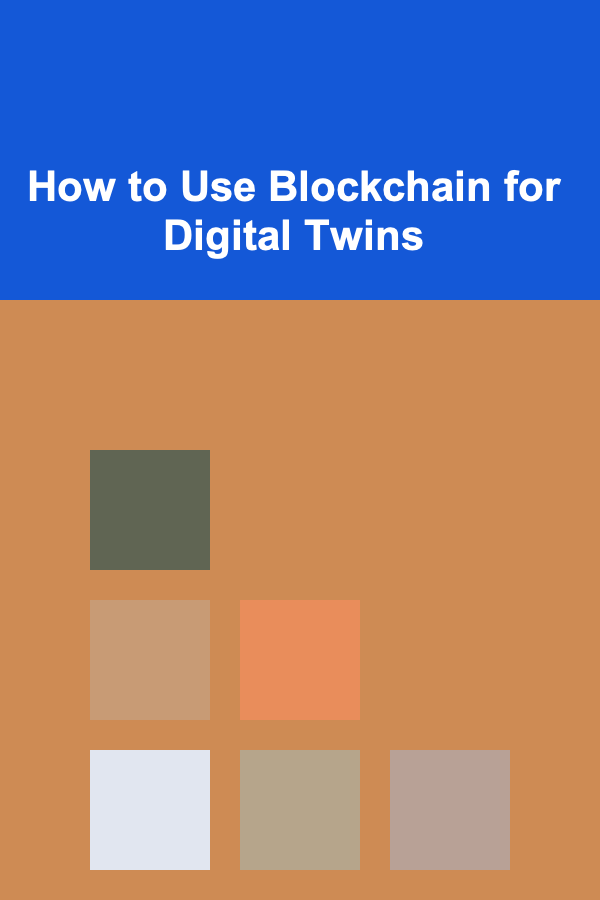
How to Use Blockchain for Digital Twins
ebook include PDF & Audio bundle (Micro Guide)
$12.99$7.99
Limited Time Offer! Order within the next:

In recent years, the advent of emerging technologies such as blockchain and digital twins has captured the attention of industries worldwide. Both have shown immense potential to transform sectors ranging from manufacturing and healthcare to supply chain management and smart cities. While blockchain has primarily been associated with cryptocurrencies, its applications extend far beyond digital currencies, particularly when combined with the concept of digital twins. This article delves deep into the intersection of these two transformative technologies and explores how blockchain can enhance the functionality, security, and efficiency of digital twin systems.
What Are Digital Twins?
A digital twin is a virtual replica of a physical object, system, or process that exists in the real world. These digital representations simulate the real-world counterpart in real-time, providing valuable insights that can help optimize performance, reduce downtime, and predict potential failures. Digital twins are typically used in manufacturing, engineering, smart cities, healthcare, and various other industries to model and monitor physical assets or processes.
For example, in a manufacturing facility, a digital twin of a machine could track its operating conditions, detect anomalies, and predict maintenance needs. In the context of smart cities, digital twins can be used to simulate traffic flow, energy consumption, and other critical infrastructure parameters to improve urban planning.
The core benefit of digital twins lies in their ability to bridge the physical and digital worlds. By using real-time data from sensors, IoT devices, and other sources, a digital twin can mirror the real-world behavior of an asset or system. This allows for predictive maintenance, performance optimization, and better decision-making.
What Is Blockchain?
Blockchain is a decentralized and distributed ledger technology that enables secure, transparent, and immutable record-keeping. At its core, blockchain consists of a chain of blocks, where each block contains a set of transactions. Once a block is added to the chain, it is almost impossible to alter or delete the data within it, making blockchain a highly secure way of storing and transmitting information.
Although blockchain is most commonly known for its use in cryptocurrencies like Bitcoin, its potential extends far beyond this domain. Blockchain's characteristics of decentralization, transparency, and immutability make it a powerful tool for various applications, including supply chain management, voting systems, digital identity, and even healthcare.
One of the key advantages of blockchain is its ability to provide a single, trustworthy source of truth. This can be particularly beneficial in environments where multiple parties need to collaborate but cannot fully trust one another. Blockchain ensures that all participants in a network have access to the same information and that the data is tamper-resistant.
How Blockchain Can Enhance Digital Twins
While digital twins offer significant benefits, they also face challenges related to data integrity, security, and scalability. These challenges can be mitigated by incorporating blockchain technology. Here are several ways in which blockchain can enhance digital twins:
1. Data Integrity and Immutability
One of the primary concerns when using digital twins is ensuring that the data used to create and update the virtual model is accurate and tamper-proof. Since digital twins rely heavily on real-time data from sensors, IoT devices, and other sources, the quality of this data is crucial for the accuracy of the digital twin. If the data is altered or manipulated, the entire digital twin model may become unreliable.
Blockchain provides an immutable ledger that can record all the data generated by sensors and devices in a digital twin ecosystem. Once data is added to the blockchain, it cannot be changed or deleted, ensuring the integrity of the data. This means that any updates to a digital twin are securely recorded, and all stakeholders can trust the accuracy of the data.
For instance, in the case of industrial machines with digital twins, blockchain can verify that the data captured from sensors (such as temperature, vibration, and pressure readings) is authentic and has not been tampered with. This adds a layer of trust, particularly when multiple parties are involved in the management of the physical assets.
2. Decentralized Data Management
Traditional digital twin systems often rely on centralized data storage, which can be a vulnerability. If a single point of failure occurs, it could compromise the entire system. Blockchain's decentralized nature can mitigate this risk by allowing data to be stored across multiple nodes in a network. Each participant in the blockchain network has access to the same information, making the system more resilient to data loss or corruption.
In a decentralized blockchain-based digital twin system, different stakeholders (such as manufacturers, operators, and service providers) can securely access and update the digital twin without relying on a central authority. This creates a more collaborative environment where all parties can trust the data and make informed decisions based on the same information.
3. Enhanced Security and Privacy
Digital twins often involve sensitive data related to assets, processes, or individuals. This data may include information about machinery performance, supply chain logistics, or even personal health records. Securing this data is critical to prevent unauthorized access and protect privacy.
Blockchain can provide enhanced security by using cryptographic techniques to secure data. Each block in the blockchain is linked to the previous one, creating a chain that is difficult to tamper with. Additionally, blockchain networks can use public and private keys to ensure that only authorized parties can access or modify the data associated with a digital twin.
In some cases, blockchain can also enable the use of smart contracts, which are self-executing contracts with the terms of the agreement directly written into the code. Smart contracts can automate certain actions in a digital twin ecosystem, such as triggering maintenance schedules or verifying the authenticity of data, without the need for intermediaries. This adds an extra layer of security and trust to the system.
4. Traceability and Auditability
One of the key advantages of blockchain is its ability to provide an auditable trail of transactions. In a digital twin system, this means that every change made to the digital twin model can be traced back to its source. This is particularly useful in industries like manufacturing, where knowing the history of a product or asset is essential for quality control and compliance.
For example, in the automotive industry, blockchain can be used to track the entire lifecycle of a vehicle, from its manufacturing to its maintenance and repairs. Each time a part is replaced or a service is performed, the information is recorded on the blockchain. This creates an immutable record of the vehicle's history, which can be accessed by manufacturers, service providers, and even customers.
The traceability feature of blockchain also allows for better accountability in a digital twin ecosystem. If an issue arises with a physical asset, it is easier to identify where the problem occurred and who was responsible for it.
5. Interoperability Between Different Systems
In many industries, digital twins are part of a larger ecosystem that includes various systems, devices, and stakeholders. Ensuring that these different systems can work together seamlessly is a significant challenge. Blockchain can help by providing a standardized and secure method for exchanging data between different platforms.
Blockchain's decentralized nature allows different systems to communicate with each other without the need for a central intermediary. This enables interoperability between various digital twin platforms, regardless of the underlying technology or infrastructure. As a result, different industries and sectors can more easily collaborate and share data, leading to more efficient operations and better decision-making.
For example, in the context of smart cities, blockchain can enable the integration of digital twins of buildings, transportation systems, and energy grids. These different systems can share data in real-time, leading to more optimized urban planning and management.
6. Automation Through Smart Contracts
Smart contracts are self-executing contracts that automatically enforce the terms of an agreement when certain conditions are met. In the context of digital twins, smart contracts can be used to automate various processes, such as maintenance scheduling, asset performance monitoring, and supply chain management.
For example, if a sensor in a manufacturing plant detects that a machine is about to fail, a smart contract could automatically trigger a maintenance request or order replacement parts. The smart contract would execute this action without the need for human intervention, reducing the time and cost associated with manual processes.
Smart contracts can also help ensure that all parties in a digital twin ecosystem fulfill their obligations. For instance, if a service provider is contracted to maintain a piece of equipment, a smart contract could ensure that the provider is paid only once the maintenance work has been completed and verified by the digital twin.
7. Tokenization and Incentive Mechanisms
Blockchain's ability to create and manage digital tokens opens up new possibilities for incentivizing participants in a digital twin ecosystem. For example, tokens could be used to reward individuals or organizations that contribute valuable data or perform actions that improve the system. This could include providing accurate sensor data, completing maintenance tasks, or collaborating on system improvements.
Tokenization can also facilitate the creation of decentralized marketplaces where participants can buy and sell digital assets related to the digital twin ecosystem. For example, in the context of supply chain management, companies could trade digital assets representing physical goods, services, or even information about asset performance.
These incentive mechanisms can encourage more collaboration, data sharing, and innovation within the digital twin ecosystem, ultimately leading to better outcomes for all stakeholders.
Conclusion
The combination of blockchain and digital twins has the potential to revolutionize various industries by improving data integrity, security, and collaboration. Blockchain's decentralized, transparent, and immutable nature enhances the functionality of digital twins by ensuring that the data used to update and manage these models is trustworthy and tamper-proof. By integrating blockchain, digital twins can become more secure, scalable, and interoperable, opening up new possibilities for automation, traceability, and real-time decision-making.
As industries continue to adopt digital twin technology, blockchain will play an increasingly important role in ensuring the reliability and security of these systems. Whether it's in manufacturing, healthcare, smart cities, or supply chain management, the synergy between blockchain and digital twins will drive innovation, improve operational efficiency, and unlock new opportunities for growth and collaboration.

How to Clean Your Bathroom in Under 15 Minutes
Read More
How to Decorate Your Bathroom with Affordable Accessories
Read More
How to Integrate SMS Automation Tools with Your Dropshipping Platform for Abandoned Cart Recovery
Read More
How to Set Up a Home Maintenance Schedule
Read More
Renewable Energy for Electric Vehicles: Powering a Sustainable Future
Read More
How to Find Your Unique Voice
Read MoreOther Products

How to Clean Your Bathroom in Under 15 Minutes
Read More
How to Decorate Your Bathroom with Affordable Accessories
Read More
How to Integrate SMS Automation Tools with Your Dropshipping Platform for Abandoned Cart Recovery
Read More
How to Set Up a Home Maintenance Schedule
Read More
Renewable Energy for Electric Vehicles: Powering a Sustainable Future
Read More